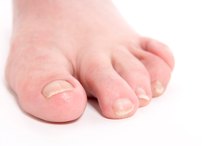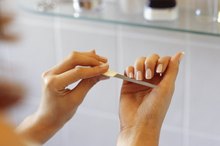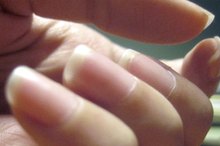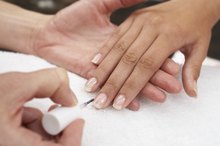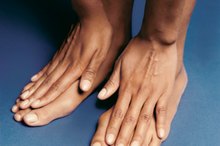What does fact checked mean?
At Healthfully, we strive to deliver objective content that is accurate and up-to-date. Our team periodically reviews articles in order to ensure content quality. The sources cited below consist of evidence from peer-reviewed journals, prominent medical organizations, academic associations, and government data.
The information contained on this site is for informational purposes only, and should not be used as a substitute for the advice of a professional health care provider. Please check with the appropriate physician regarding health questions and concerns. Although we strive to deliver accurate and up-to-date information, no guarantee to that effect is made.
Weak Nails That Curve Up
Just as the eyes are the windows to the soul, your nails can sometimes speak volumes about your physical health. Weak nails that curve up or nails that are pitted, horizontally ridged or discolored can tell your doctor that you have an underlying medical condition that requires treatment. If you have "spoon nails," or koilonychia, don't hesitate to see your treating physician.
About Koilonychia
Koilonychia, the medical term given to weak nails that curl upward, have a unique presentation. According to the Mayo Clinic, the nail bed itself is concave, and in more extreme cases is "scooped out" enough to hold a small drop of liquid. The nail itself is thin and fragile.
- Koilonychia, the medical term given to weak nails that curl upward, have a unique presentation.
- According to the Mayo Clinic, the nail bed itself is concave, and in more extreme cases is "scooped out" enough to hold a small drop of liquid.
Primary Association
What Do Ridges in Toenails Mean?
Learn More
Koilonychia is primarily associated with iron deficiency anemia, according to the University of Maryland Medical Center 12. However, a March 2004 article in the American Family Physician states that "spoon nails" can be associated with iron deficiency, regardless if anemia itself is present.
Iron Deficiency
Iron is a part of hemoglobin, the protein in your blood that transports oxygen throughout your body. Anemia, of which there is more than one type, results when your body doesn't manufacture enough red blood cells to get oxygen to your body tissues. Iron deficiency anemia is simply a type of anemia that's caused when you don't have enough iron. The University of Maryland Medical Center cites the main reasons for iron deficiency as poor iron absorption, blood loss and an iron-deficient diet 12.
- Iron is a part of hemoglobin, the protein in your blood that transports oxygen throughout your body.
- Anemia, of which there is more than one type, results when your body doesn't manufacture enough red blood cells to get oxygen to your body tissues.
Other Causes for "Spoon Nails"
Brittle Nails With Ridges
Learn More
Koilonychia can also be caused by trauma to the nail, repeated exposure of the nails to petroleum-based solvents, such as in an occupational setting, or nail-patella syndrome, according to the American Family Physician article 3. "Spoon nails" have also been noticed in patients who suffer from hemochromatosis, Raynaud's disease and lupus. Sometimes infants and small children exhibit koilonychia, but this generally resolves within the first few years after birth.
More About Nails
If you simply have soft, brittle, splitting nails, it's not likely that you have a nail disorder caused by a systemic disease or iron deficiency, states the American Osteopathic College of Dermatology. The most common problems with nails–fingernails in particular–is caused by repeated wetting and drying, such as damage caused by household chores such as mopping and dishwashing, which in turn makes them dry and fragile. However, if your nails present with a marked upward tilt and depressed nail bed, or if you notice any other abnormalities, it's best to consult with your treating physician 3. If koilonychia is present, the American Family Physician states that doctors should conduct diagnostic testing to rule out unidentified health concerns 4.
Related Articles
References
- University of Maryland Medical Center: Nail Disorders
- University of Maryland Medical Center: Iron Deficienty Anemia
- American Family Physician: Nail Abnormalities: Clues to Systemic Disease
- National Institutes of Health: Koilonychia
- Singal A, Arora R. Nail as a window of systemic diseases. Indian Dermatol Online J. 2015;6(2):67-74. doi:10.4103/2229-5178.153002
- Yaemsiri S, Hou N, Slining MM, He K. Growth rate of human fingernails and toenails in healthy American young adults. J Eur Acad Dermatol Venereol. 2010;24(4):420-3. doi:10.1111/j.1468-3083.2009.03426.x
- Schons KR, Knob CF, Murussi N, Beber AA, Neumaier W, Monticielo OA. Nail psoriasis: a review of the literature. An Bras Dermatol. 2014;89(2):312-7. doi:10.1590/abd1806-4841.20142633
- Abdullah L, Abbas O. Common nail changes and disorders in older people: Diagnosis and management. Can Fam Physician. 2011;57(2):173-81.
- Sarkar M, Mahesh DM, Madabhavi I. Digital clubbing. Lung India. 2012;29(4):354-62. doi:10.4103/0970-2113.102824
- Haneke E. Controversies in the treatment of ingrown nails. Dermatol Res Pract. 2012;2012:783924. doi:10.1155/2012/783924
- Jefferson J, Rich P. Melanonychia. Dermatol Res Pract. 2012;2012:952186. doi:10.1155/2012/952186
- Aging Changes in Hair and Nails. Medline. National Institutes of Health Public Information Sheet.
- Nails and Nail Problems. American Academy of Dermatology Public Information Sheet.
Writer Bio
Lisa Sefcik has been writing professionally since 1987. Her subject matter includes pet care, travel, consumer reviews, classical music and entertainment. She's worked as a policy analyst, news reporter and freelance writer/columnist for Cox Publications and numerous national print publications. Sefcik holds a paralegal certification as well as degrees in journalism and piano performance from the University of Texas at Austin.
